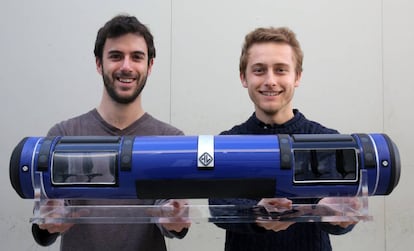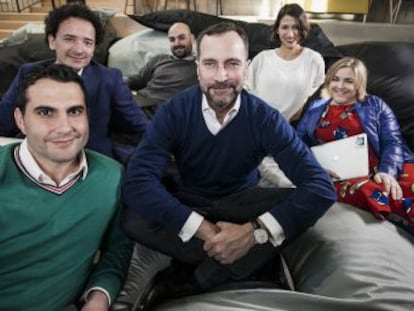Spanish university team designs 1,000km/h ¡°flying¡± Hyperloop train
Valencia Polytechnic rolls into final phase of Elon Musk¡¯s SpaceX high-speed transportation competition

A team of Spanish university students is to present their prototype of a train capable of traveling up to 1,000km/h this summer in the next phase of the Hyperloop Pod Competition, the contest to create a long-distance, high-speed transportation system set up by billionaire entrepreneur Elon Musk, the co-founder of the Tesla electric car company, among other tech initiatives.

Five students from the Polytechnic University of Valencia (UPV) began work on their project more than a year ago and have now been joined by 25 others with the goal of presenting the train at the final Hyperloop trials this summer to be held at Musk¡¯s SpaceX headquarters in Los Angeles. Musk¡¯s challenge to universities around the world is to come up with a system to propel a pod-like vehicle through a near-vacuum tube at more than airline speed.
The UPV team was selected in January 2016 by a SpaceX panel from dozens of universities to present their project. After securing sponsorship, UPV Hyperloop is now further honing their design of a two-meter-long, 1.5-meter-high pod, which has cost some €100,000 and will be tested at SpaceX in a few months.
Musk is like a rock star. He insisted that we were taking part in something unique Juan Vic¨¦n, UPV team member
The team was set up after one of its number learned about Musk¡¯s Hyperloop initiative in 2015. It is now competing with around 30 institutions, including the Massachusetts Institute of Technology (MIT), whose prototype was chosen as best design in 2016; Munich University, which was judged to have come up with the fastest and most stable model; and Delft University, which won the most points in all categories at the January 2017 Hyperloop event, held at SpaceX headquarters in Los Angeles.
In January of this year, the team traveled to Los Angeles, where they were able to see the Hyperloop¡¯s 1.5 kilometer test circuit, one of the largest vacuum chambers in the world.
¡°We saw prototypes that can fit in a suitcase and others that weighed more than 1.5 tons,¡± says Juan Vic¨¦n, a founder member of the team.
¡°The technology already exists and is being used in different fields: the idea now is to combine it and apply it to this project,¡± says fellow founder member Daniel Orient, explaining that the concept is a combination of a train infrastructure with aviation technology.
Vic¨¦n says he doesn¡¯t know what will happen after the second phase of the competition this summer. ¡°Nobody can guarantee that when you invent a means of transport it will work perfectly, but there are signs that this could be viable and we want to do everything possible to contribute to it,¡± he explains. The UPV team says the technology could be used to connect Europe¡¯s main ports for the transportation of goods.
Musk¡¯s challenge is to devise a system to propel a vehicle through a near-vacuum tube at more than airline speed
The team members say they were impressed by Musk. ¡°He¡¯s like a rock star. He encouraged us to continue and insisted that we were taking part in something unique,¡± says Vic¨¦n.
Elon Musk dubbed Hyperloop ¡°the fifth form of transportation¡± when he launched the idea in 2012. The concept is not dissimilar to Japan¡¯s bullet train, which uses magnetic fields to float above rails. But Hyperloop aims to reach speeds of up to 1,000km/h by avoiding air friction.
Musk put together a team to work on a theoretical model in 2013, and since then, has invited the scientific community to come up with the best way to put theory into practice.
Hyperloop One and Hyperloop Transportation Technologies (HTT) are two US companies now working on their own prototypes. The first has already secured €130 million in financing and is now building installations to put the technology needed to the test, saying it intends to come up with a working system by 2020. In May 2016 it demonstrated its progress in Las Vegas.
HTT will be based in the French city of Toulouse. Although it has so far only raised €25 million to date, it has already reached an agreement with the Slovak government and the city of Brno to carry out a viability study to link it with the Czech city of Bratislava. The company¡¯s director aims to have built a prototype by the end of the year.
English version by Nick Lyne.
Tu suscripci¨®n se est¨¢ usando en otro dispositivo
?Quieres a?adir otro usuario a tu suscripci¨®n?
Si contin¨²as leyendo en este dispositivo, no se podr¨¢ leer en el otro.
FlechaTu suscripci¨®n se est¨¢ usando en otro dispositivo y solo puedes acceder a EL PA?S desde un dispositivo a la vez.
Si quieres compartir tu cuenta, cambia tu suscripci¨®n a la modalidad Premium, as¨ª podr¨¢s a?adir otro usuario. Cada uno acceder¨¢ con su propia cuenta de email, lo que os permitir¨¢ personalizar vuestra experiencia en EL PA?S.
?Tienes una suscripci¨®n de empresa? Accede aqu¨ª para contratar m¨¢s cuentas.
En el caso de no saber qui¨¦n est¨¢ usando tu cuenta, te recomendamos cambiar tu contrase?a aqu¨ª.
Si decides continuar compartiendo tu cuenta, este mensaje se mostrar¨¢ en tu dispositivo y en el de la otra persona que est¨¢ usando tu cuenta de forma indefinida, afectando a tu experiencia de lectura. Puedes consultar aqu¨ª los t¨¦rminos y condiciones de la suscripci¨®n digital.










































